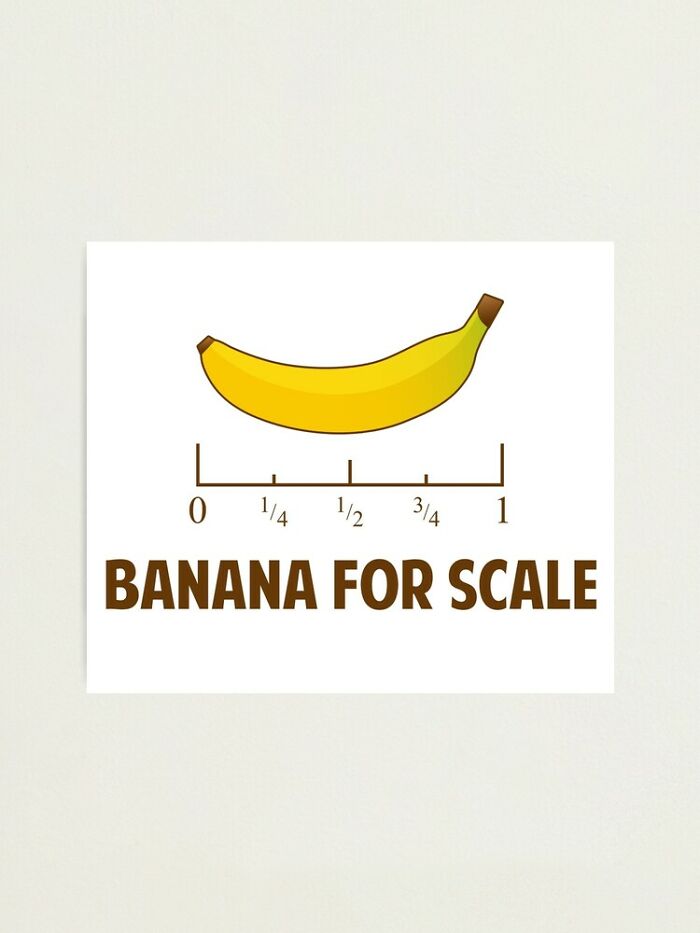As part of my professional life, I teach subjects in mechanical engineering and machining trades. During one of the pandemic lockdowns, I was running a class on metrology, the science of measurement, and for a humourous lesson, I started showing weird measurements that are recognized, so using “banana for scale” I hope everyone gets as much laughter and confusion as my students did.
#1 Banana For Scale
According to the U.S. Department of Agriculture, a banana is at least 7 inches, or 177.8 millimeters, but no longer than 8 inches, or 203.2 millimeters.

#2 Beard-Second – 5 Nanometres
Inspired by the light-year but defined as the length an average physicist’s beard grows in one second.

#3 Mickey – 0.1mm
The smallest detectable movement was registered by a computer mouse and was named after Mickey Mouse.

#4 Pyramid Inch – 1.00106″ Or 25.426924mm
This unit of measurement has been determined by Pyramidologists as being 1/25 of the sacred measurement the Cubit.

#5 Shake – 10 Nanoseconds
This dandy was developed by nuclear engineers and astrophysicists from the old saying “two shakes of a lamb’s tail”.

#6 Banana – 78 Nanosieverts
Once again our friend the banana is utilized. This time the unit of measurement is the severity of radiation one might be exposed to.

#7 Smoot – 67″ Or 1.70m
This distance was developed based on the height of Oliver Smoot, a Harvard fraternity pledge in 1958. The fraternity used Oliver to measure the Harvard Bridge. It worked out to be 364.4 Smoots +/- one ear. Oliver Smoot would later become the chairman at ANSI and president of ISO. Both organizations are responsible for standardizing measurements and engineering.

#8 Jiffy – 0.01 Seconds
The jiffy was designated from the world of computers. The allocated time is the duration of one tick of the system’s timer interrupt. Earlier computers, like 8-bit Commodores, had a jiffy at 1/60 of a second.

#9 Warhol – 15 Minutes
This measurement is owing its origin to Andy Warhol who stated “everyone will be world-famous for 15 minutes”.

#10 Nibble – 4-Bits
The nibble is half of an 8-bit byte, which is 1 hexadecimal digit.

#11 Big Mac Index
The magazine, The Economist, came up with this oddball measurement which compares nations purchasing power parity to the cost of a Big Mac hamburger.

#12 Sagan – 4 Billion
A humourous tribute to Carl Sagan and the phrase “billions and billions” that he was often known to say. So a Sagan is used to describe a large amount, with 4 billion as the accepted minimum.

#13 Micro-Century – 52 Minutes 35.7 Seconds
This is attributed to mathematician John von Neumann. This is the maximum length of a lecture, which also works out to be one-millionth of a century.

#14 Garn – Level Of Incapacitation Due To Nausea
NASA developed this measurement to register the amount of nausea and motion sickness related to space travel. Jake Garn, a NASA astronaut, was known to become sick during tests and when in orbit with great frequency. The value of one Garn means the person is basically incapacitated.

#15 Rictus – Level Of Media Coverage
Tom Weller, the author of Science Made Stupid, coined this term as a parody of the Richter scale for earthquakes. His “Rictus” scale, which measures from 1 thru 5, is designed to measure the amount of media coverage an event garners.

#16 Megalithic Yard – 0.9074 Yards Or 0.8297 Metres
Scottish professor of engineering, Alexander Thom, concluded this measurement was the common unit used after analyzing over 250 megalithic sites in England and Scotland.

#17 Furman – 1/65536 Of A Circle
This is named after mathematician Alan T. Furman who adapted the CORDIC algorithm for 16-bit fixed point arithmetic.

#18 Barn-Megaparsec – 2/3 Teaspoon Or 3.33ml
This is the combination of the Barn (b) used in nuclear physics and the megaparsec (Mpc) which is used to measure the distance between galaxies.

#19 Barn – 1.0×10−28 M2
Developed by nuclear physicists in reference to “you couldn’t hit the broad side of a barn” when discussing the probability of the collision of particles in an accelerator.

 Follow Us
Follow Us





